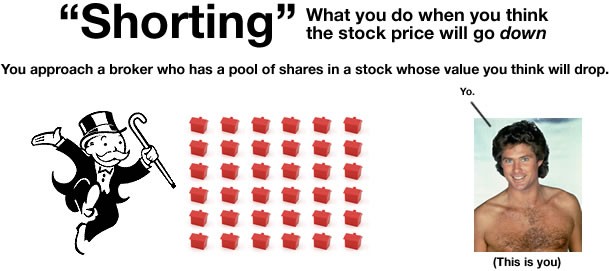Fool FAQ Shorting Stocks
Post on: 23 Июнь, 2015 No Comment

Many times on the Fool boards I’ve seen references to `selling a stock short’ or `taking a short position.’ Will someone tell me plainly what shorting is?
An investor who sells stock short borrows shares from a brokerage house and sells them to another buyer. Proceeds from the sale go into the shorter’s account. He must buy those shares back (cover) at some point in time and return them to the lender.
Thus, if you sell short 1000 shares of Gardner’s Gondolas at $20 a share, your account gets credited with $20,000. If the boats start sinking—since David Gardner, founder and CEO of VENI, knows nothing about their design—and the stock follows suit, tumbling to new lows, then you will start thinking about covering your short there for a very nice profit. Here’s the record of transactions if the stock falls to $8.
Borrowed and Sold Short 1000 shares at $20: +$20,000
Bought back and returned 1000 shares at $8: -$8,000
Profit: + $12,000
But what happens if as the stock is falling, Tom Gardner, boatsmen extraordinaire, takes over the company at his brother’s behest, and the holes and leaks are covered. As the stock begins to takes off, from $14 to $19 to $26 to $37, you finally decide that you’d better swallow hard and close out the transaction. You do so, buying back shares of TOMY (new ticker symbol) at $37.
Here’s the record of transaction:
Borrowed and sold short 1000 shares at $20: +$20,000
Bought back and returned 1000 shares at $37: -$37,000
Loss: -$17,000
Ouch. So you see, in the second scenario, when I, your nemesis, took over the company, you lost $17,000. which you’ll have to come up with. There’s the danger. you have to be able to buy back the shares that you initially borrowed and sold. Whether the price is higher or lower, you’re going to need to buy back the shares at some point in time.
To learn more about short selling, try reading the following books: Tools of the Bear: How Any Investor Can Make Money When Stocks Go Down — Charles J. Caes; Financial Shenanigans: How To Detect Accounting Gimmicks & Fraud — Howard M. Shilit; When Stocks Crash Nicely: The Finer Art of Short Selling — Kathry F. Staley; Selling Short: Risks, Rewards and Strategies for Short Selling Stocks, Options and Futures — Joseph A. Walker. None of these are perfect in their coverage of short selling but each has its strengths.
Shorting, unlike puts, seems to have an unlimited downside potential, correct? That is, hypothetically, the stock can rise to infinity. Puts, besides the time limit, have a limited downside. Why then, for a short term short, would anyone short instead of purchasing puts?
Theoretically, yes. In reality, no. Because in our number system we count upwards and don’t stop, we opine that because numbers go on forever, so can a stock price. But when we think about this objectively, it seems kind of silly, no? Obviously a stock price, which at SOME point reflects actual value in a business, cannot go on to infinity.
Yes, puts do have a limited downside. However, options have an expiration date, which means that they are time-wasting assets. They also have a strike price which means that you need to pick a price and then have the stock below it on expiration date. Finally, you have to pay a premium for an option and if you are not in the money more than the premium, by expiration day, you still lose. So, with options, not only do you have to be worried about the direction of the stock, you need to be correct about the magnitude of the move and the time in which it will happen. And even then, even if you successfully manage all 3 of these things, you can still lose money if you don’t cover the premium. Not very Foolish. With shorting, you only really need to be concerned about direction. As for limiting liability, you can do that yourself by putting in a buy stop at a price where the loss is too much for you.
What is short interest? Does it have anything to do with short attention spans?
Pardon? Short interest? Oh yes! Ahem, short interest is simply the total number of shares of a company that have been sold short. The Fool believes that the best shorts are those with low short interest. They present the maximum chance for price depreciation as few short sales have occurred, driving down the price. Also, low short interest stocks are less susceptible to short squeezes (see below). Short interest figures are available towards the end of each month in financial publications like Barron’s and the Investor’s Business Daily .
The significance of short interest is relative. If a company has 100 million shares outstanding and trades 6 million shares a day, a short interest of 3 million shares is probably not significant (depending on how many shares are closely held). But a short interest of 3 million for a company with 10 million shares outstanding trading only 100,000 shares a day is quite high.
I’ve heard the term ‘days to cover’ thrown around quite a bit. Does ‘days to cover’ have anything to do with short interest?
Yes, it does! Days to cover is a function of how many shares of a particular company have been sold short. It is calculated by dividing the number of shares sold short by the average daily trading volume.
Look at Ichabod’s Noggins (Nasdaq:HEAD). One million shares of this issue have been sold short (we can find this number, called the short interest, in such publications as Barrons and the IBD). It has an average trading volume of 25,000. The days to cover is 1,000,000/25,000, or 40 days.
When you short a stock, you want the days to cover to be low, say around 7 days or so. This will make the shares less subject to a short squeeze, the nightmare of shorters in which someone starts buying up the shares and driving up the share price. This induces shorters to buy back their shares, which also drives up the price! A short days to cover means the short interest can be eliminated quickly, preventing a short squeeze from working very well.

Also, a lengthy days to cover means that many people have already sold short the stock, making a further decline less likely.
What effect does a large short coverage have (generally) on the stock`s price? Generally, heavy buying increases the price while selling decreases it. Assuming the stocks price has been steady, or climbing, and many shorters attempt to cover their losses, how will this affect the price?
What you are referring to, in investment parlance, is a short squeeze. When a number of short sellers all try to cover their short at the same time, that does indeed drive the stock up.
Our approach when shorting is therefore to avoid in general stocks that already have a fairly hefty amount of existing short sales. We try to set ourselves up so we’ll never get squeezed.
I’ll point out that short squeezes can be the result of better than expected earnings or some other fundamental aspects of a company’s operation. They can also be the result of direct manipulation. That is, profit-seeking individuals with large amounts of cash at their disposal can look on a large short position in a stock as an invitation to start buying, driving up the share prices, thus forcing short-sellers to cover. This in turn drives up the price, and before you know it, the share price has soared!
OK, I understand the potential benefits and risks of shorting, except for one thing. If the stock I’ve shorted pays a dividend, am I liable for that dividend?
Yes. If you are short as of the ex-dividend date, you are liable to pay the dividend to the person whose shares you have borrowed to make your short sale. I must say, however, that if you are correct in your judgment to sell the issue short, your profits achieved thereby will certainly outweigh the small dollar amount of the dividend payout.
What happens if the stock I’ve shorted splits?
MF Swagman replies:
Let’s say we’re speaking of a two-for-one split. In that case, all that happens is that you must cover your short position with twice as many shares as you opened it. If you shorted 100 shares, you must cover with 200. Don’t forget, though, that the magnitude of your investment hasn’t changed, for while you now have twice as many shares, each one is only worth half as much as before! So, while your original cost basis for the 100 shares may have $36, now, with 200 shares, it is only $18.
This is a very foolish question, I’m sure, but if I sell short I am essentially borrowing the shares from someone else through my broker. Assuming that the lender does NOT need the shares prematurely, what determines how long I can stay short? (pun intended) How long do I have before I am forced to cover my position? Is there any regulation? Is it simply dependent on when/if the broker needs them? Could I possibly stay short for an indefinite period?
As far as I know, there is no pre-determined limit to how long you can keep your short position open. Technically, you could be forced to cover at any time, but typically, having the shares you have borrowed called back is unusual. At least so state all the Schwab representatives of whom I have asked this question.














